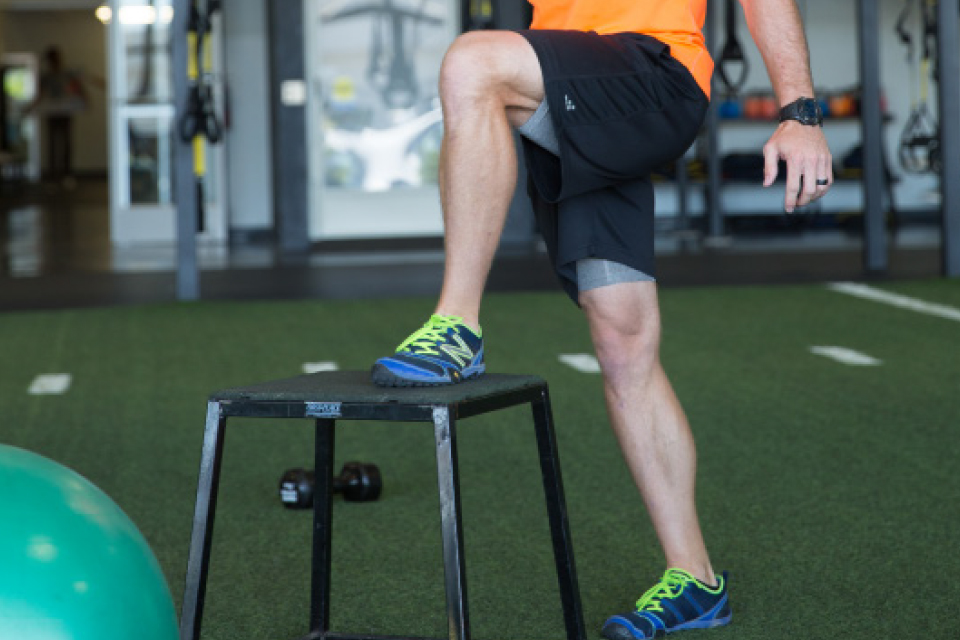Workout: Expand Lower Body Forces with Speed, Strength and Stability

Many trainers and athletes search for that sweet spot in their workouts, something that will engage the full spectrum of stability, strength expression and speed of movement. When we emphasize these movement expressions with the lower body, we can progress with a purpose. This lower body circuit is designed to integrate more dynamic movements and provide a wide range of benefits.
First, we introduce a lower body movement that is challenging not only with an upper body combination, but also with added active resistance. That means that the water-filled stability ball is creating a vibration and impact at the end range of motion during a specific movement. This tests the deceleration ability of the movement and demands that you maintain proper posture and position through the entire movement, including the extra effort to control the water splashing inside the ball. Many injuries occur during fatigue at end ranges during deceleration. This technique using the water-filled implemention will increase the reflexive stability to assist becoming stronger and more injury resistant.
Lunge and Chop with Water Ball

Purpose: Perform the lunge and demand stability strength to be maintained while challenging the position with an upper body chop using a water-filled stability ball. We recommend 8-12 lbs. of water and pump the ball up completely to make sure the water is very actively splashing to create vibration and shifting.
Start with feet hip-width apart and the water-ball held in front of the body.
At the same time that you lunge forward, chop with the ball by maintaining arms extended and raising the ball directly overhead.
Make sure to keep the torso vertically aligned all the way through the movement.
Return to start by pushing off the forward heel to engage lower body, then return to standing as you lower the ball to the start position as well.
Second, we know that using an off-center base of support in something like a step-up will challenge the muscles and dynamic motor control in a slightly different way. Here we use a midline cross-over to change the base and engage the posterior chain muscles to create slightly different challenges for force expression and great stability.
Cross-Over Step Up with One Dumbbell

Purpose: Use the cross-over start to challenge movement strategies for engaging the step-up. The one-sided carry further challenges torso and pelvic control and position. Great for core stability strength all the way up into a single leg stance. Great exercise for runners.
Start with left foot firmly on the box with the shin vertical. The ground-based, right foot points forward with the leg crossing the midline of the body.
Hold one dumbbell in the right hand in a shoulder carry position.
Press the left foot through the box to extend the leg and at the same time in a smooth, controlled motion bring the right leg up until you achieve a single leg stance on the box.
Lower yourself back down under control by flexing the left leg and reaching with the right crossing the midline back to start.
Finish all reps, then switch to begin with right foot on the box.
Finally, we work on power. Power and speed of movement easily increase the lower body movement demands and increase the ability to achieve power endurance. This version shown in the last movement really requires great torso and upper body control while performing a quick switch of foot position. The switch forces the lower body to then step out for strength on the same leg repeatedly, increasing strength endurance and power from this single exercise.
Switch Back Lunges

Purpose: This expresses power to accelerate and decelerate (land under control) in a split stance position while applying the challenge of a light load in the frontal plane using a one-sided load. This forces the person to resist unwanted motion laterally that could take away from forward motion.
Start in a tall standing position with the dumbbell in the left hand at the shoulder carry position.
Then lunge forward with the right leg at hip-width apart.
Once you finish decelerating the movement, perform a split jump with feet hip-width apart to quickly switch the foot positions.
Maintain an upright torso.
From that low position at landing, lunge again forward with the right leg, and repeat the split jump
Repeat this movement leading with the right leg 5-8 reps until the end of the set, and then change to lead with the left for the next set.
If you’re looking to incorporate a truly challenging lower body circuit, this one won’t disappoint. Be sure to allow one to two minutes of rest between sets as you are beginning this workload. Once you handle this workout well, then start cutting the rest to minimal rest in between to create a lower body high intensity circuit. With these big moves you will have a high energy cost and really test your strength-endurance and power-endurance.






